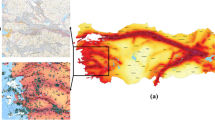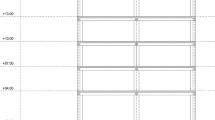Abstract
Supplemental passive dampers are generally considered as an effective tool for controlling the seismic response of multi-storey buildings. Given that the optimization of the placement of passive dampers in buildings can potentially lead to an improvement in structural performance or reduction in construction cost, an increasing number of studies have engaged in improving the damper placement strategies in buildings, including employing stochastic optimizations with genetic algorithms. Furthermore, many studies have been conducted to investigate the height-wise damper placement issues in regular buildings. Hence, the variation in the building stiffness, which potentially influences the optimization problem, is seldom addressed. In addition, the effectiveness of using genetic algorithms should be comprehensively evaluated while considering damper optimization in different structural arrangements. In this study, a benchmark model is established for assessing the height-wise damper optimization problem in irregular buildings. Furthermore, a systematic optimization framework that integrates seismic nonlinear time history analysis and genetic algorithms is proposed. The damper optimizations in regular and irregular buildings are comprehensively explored, and the performances of buildings under strong stochastic earthquakes are thoroughly studied. A few robust classical earthquakes are used to evaluate the seismic performance of benchmark buildings. The intermediate search process of evolutionary algorithms is explicitly assessed in terms of the searching ability. Finally, a comprehensive evaluation is conducted on the performance of genetic algorithms for optimizing damper distribution in regular and irregular buildings from a seismic perspective.

















Similar content being viewed by others
References
Christopoulos, C., Filiatrault, A., Bertero, V. V. (2006). Principles of passive supplemental damping and seismic isolation. Iuss press.
Lee, K.S.; Ricles, J.; Sause, R.: Performance-based seismic design of steel MRFs with elastomeric dampers. J. Struct. Eng. 135(5), 489–498 (2009)
Karavasilis, T.L.; Sause, R.; Ricles, J.M.: Seismic design and evaluation of steel moment-resisting frames with compressed elastomer dampers. Earthquake Eng. Struct. Dynam. 41(3), 411–429 (2012)
Shen, H.; Zhang, R.; Weng, D.; Ge, Q.; Wang, C.; Islam, M.M.: Design method of structural retrofitting using viscous dampers based on elastic–plastic response reduction curve. Eng. Struct. 208, 109917 (2020)
Ashour, S.A. (1987). Elastic seismic response of building with supplemental damping. (Doctoral Dissertation). Michigan Univ., Ann Arbor (USA).
Hahn, G.D.; Sathiavageeswaran, K.R.: Effects of added-damper distribution on the seismic response of buildings. Comput. Struct. 43(5), 941–950 (1992)
Zhang, R.H.; Soong, T.T.: Seismic design of viscoelastic dampers for structural applications. J. Struct. Eng. 118(5), 1375–1392 (1992)
Lopez-Garcia, D.: A simple method for the design of optimal damper configurations in MDOF structures. Earthq. Spectra 17(3), 387–398 (2001)
Takewaki, I.: Optimal damper placement for minimum transfer functions. Earthquake Eng. Struct. Dynam. 26(11), 1113–1124 (1997)
Takewaki, I.: Optimal damper placement for planar building frames using transfer functions. Struct. Multidiscip. Optim. 20(4), 280–287 (2000)
Takewaki, I. (2009). Building control with passive dampers: optimal performance-based design for. Wiley.
Singh, M.P.; Moreschi, L.M.: Optimal seismic response control with dampers. Earthquake Eng. Struct. Dynam. 30(4), 553–572 (2001)
Lavan, O.; Levy, R.: Optimal design of supplemental viscous dampers for linear framed structures. Earthquake Eng. Struct. Dynam. 35(3), 337–356 (2006)
Lavan, O.; Levy, R.: Simple iterative use of Lyapunov’s solution for the linear optimal seismic design of passive devices in framed buildings. J. Earthquake Eng. 13(5), 650–666 (2009)
Singh, M.P.; Moreschi, L.M.: Optimal placement of dampers for passive response control. Earthquake Eng. Struct. Dynam. 31(4), 955–976 (2002)
Apostolakis, G.; Dargush, G.F.: Optimal seismic design of moment-resisting steel frames with hysteretic passive devices. Earthquake Eng. Struct. Dynam. 39(4), 355–376 (2010)
Whittle, J.K.; Williams, M.S.; Karavasilis, T.L.; Blakeborough, A.: A comparison of viscous damper placement methods for improving seismic building design. J. Earthquake Eng. 16(4), 540–560 (2012)
Del Gobbo, G.; Williams, M.; Blakeborough, A.: Comparing fluid viscous damper placement methods considering total-building seismic performance. Earthquake Eng. Struct. Dynam. 47(14), 2864–2886 (2018)
Pollini, N.; Lavan, O.; Amir, O.: Optimization-based minimum-cost seismic retrofitting of hysteretic frames with nonlinear fluid viscous dampers. Earthquake Eng. Struct. Dynam. 47(15), 2985–3005 (2018)
Puthanpurayil, A.M.; Lavan, O.; Dhakal, R.P.: Multi-objective loss-based optimization of viscous dampers for seismic retrofitting of irregular structures. Soil Dyn. Earthq. Eng 129, 105765 (2020)
Coley, D.A. (1999). An introduction to genetic algorithms for scientists and engineers. World Scientific Publishing Co Inc.
Vas, P. (1999). Artificial-intelligence-based electrical machines and drives: application of fuzzy, neural, fuzzy-neural, and genetic-algorithm-based techniques (Vol. 45). Oxford university press.
Apostolakis, G.: Optimal evolutionary seismic design of three-dimensional multistorey structures with damping devices. J. Struct. Eng. 146(10), 04020205 (2020)
Seleemah, A.A. and Constantinou, M.C. (1997), “Investigation of seismic response of buildings with linear and nonlinear fluid viscous dampers”, Technical Report No. NCEER-97–0004, National Center for Earthquake Engineering Research, State University of New York at Buffalo, Buffalo, NY, USA.
Taylor Devices Inc. (2021), http://www.taylordevices.com.
Mitchell, M.: An introduction to genetic algorithms. MIT Press, Cambridge (1998)
Bäck, T.: Evolutionary algorithms in theory and practice: evolution strategies, evolutionary programming, genetic algorithms. Oxford University Press (1996)
Open System for Earthquake Engineering Simulation (OpenSees) [Computer software]. (2016). University of California at Berkeley, Berkeley, CA, US: Pacific Earthquake Engineering Research Center.
MATLAB [Computer software]. (2014). Global Optimization Toolbox Release 2014b. Natick, MA, US: The MathWorks Inc.
Fajfar, P., Krawinkler, H. (2004). Performance-based seismic design concepts and implementation. in Proceedings of the International Workshop, Bled, Slovenia (Vol. 28, pp. 2004–05).
Whittle, J.K.; Williams, M.S.; Blakeborough, A.: Performance of structural members in seismic retrofitted frames with viscous dampers. University of Oxford, UK (2012)
Bhuiyan, M., Leon, R. (2013). Effect of Diaphragm flexibility on tall building responses. Structures Congress.
Seo, C.; Karavasilis, T.L.; Ricles, J.M.; Sause, R.: Seismic performance and probabilistic collapse resistance assessment of steel moment resisting frames with fluid viscous dampers. Earthquake Eng. Struct. Dyn. 43(14), 2135–2154 (2014)
FEMA P695 (2008), Quantification of building seismic performance factors, ATC-63 Project, Applied Technology Council, Redwood City, CA, USA.
Acknowledgements
We are grateful to Professor Theodore Karavasilis of the Steel Structures Research Group at the University of Patras for his assistance in performing computational analyses.
Author information
Authors and Affiliations
Corresponding author
Rights and permissions
About this article
Cite this article
Huang, X., Bae, J. Evaluation of Genetic Algorithms for Optimizing the Height-Wise Viscous Damper Distribution in Regular and Irregular Buildings. Arab J Sci Eng 47, 12945–12962 (2022). https://doi.org/10.1007/s13369-022-06646-3
Received:
Accepted:
Published:
Issue Date:
DOI: https://doi.org/10.1007/s13369-022-06646-3




